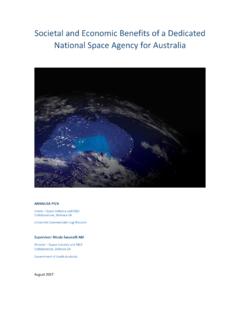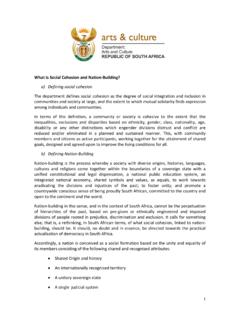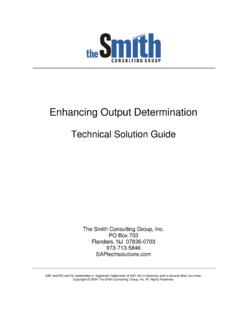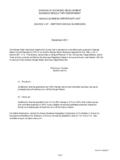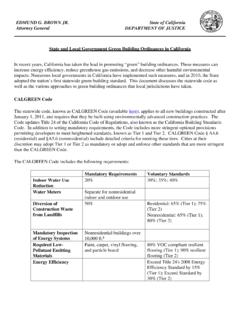Transcription of NAVAL SHIPBUILDING - Defence SA
1 NAVAL SHIPBUILDINGA ustralia s $250 billion Nation building OpportunityACKNOWLEDGEMENTSThe NAVAL SHIPBUILDING : Australia's $250 billion Nation building Opportunitydiscussion paper was commissioned by, and represents the views of, the Defence SAAdvisory Board would like to recognise key contributions from members of the Board's maritime sub-committee: General Peter Cosgrove AC MC Professor Kim Beazley AC Dr Ian Chessell Mr Malcolm Kinnaird AC Rear Admiral Trevor Ruting AM CSC RANR Vice Admiral David Shackleton AO RANR Dr John Advisory Board would like to acknowledge the major contributions from the Governor of South Australia, His Excellency Rear Admiral Kevin Scarce AC CSC RANR, Emeritus Professor Paul Dibb AM and Mr Andrew Cawley. In addition the Board would like to acknowledge comments provided by senior personnel within Defence , Defence Materiel Organisation and last two Defence White Papers (and especially the 2009 White paper) literally wrought a sea change in the nation s Defence posture.
2 There has been a reorientation of our maritime capabilities evidenced by such initiatives as the Air Warfare Destroyers, a substantially increased submarine force, a new future class of frigates, an enhanced maritime surveillance capability and a broad step-change in the potency of maritime munitions. This adds up to the most ambitious and significant array of Defence acquisitions since World War II. We will spend as a nation $250 billion over 30 years on NAVAL ships and submarines a huge infrastructure project within Australia by any measure. This creates the opportunity, indeed, the need, to revolutionise the efficiency and cost effectiveness of NAVAL SHIPBUILDING and through-life support, and to develop a sustainable national industry and skills capability which will flow through to other high tech industries.
3 Apart from cost efficiencies for Defence , the program will be a driver for jobs growth and improved social well being across the a leading State in NAVAL ship building and systems engineering, South Australia is committed to ensuring that this vital national project is achieved efficiently and successfully. Over the past 12 months, the Defence SA Advisory Board, in consultation with a broad range of stakeholders, has prepared a discussion paper on NAVAL SHIPBUILDING which explores the fundamental paths to efficiency and cost effectiveness and embraces a whole of nation commend this paper to you as a key milestone in driving toward a pragmatic and timely outcome. General Peter Cosgrove AC MCChairmanDefence SA Advisory SHIPBUILDING in Definitions32 AUSTRALIAN RAN Fleet Past, Present and White Paper 2009 Future Maritime Better Value in Future Acquisition Programs6 PART I WARSHIP COSTS73 WARSHIP Price of of Rising of NAVAL SHIPBUILDING Project Costs104 ESTIMATING WARSHIP SHIPBUILDING Cost and Non-Production Estimate Model16 PART II BUSINESS MODELS175 BUSINESS MODELS USED IN AUSTRALIAN NAVAL for Better Value Projects Projects Projects Projects Air Warfare Business Models for NAVAL SHIPBUILDING in Australia236 REVIEWS OF NAVAL SHIPBUILDING IN to NAVAL SHIPBUILDING and Repair Sector Strategic Carnegie.
4 Wylie & Company Senate Review297 OTHER NAVAL SHIPBUILDING BUSINESS s Changing of Change Strategic and Change The United Kingdom Change Alternative Business Business Models SHIPBUILDING Business Model Summary36 PART III WARSHIP CONSTRUCTION378 NAVAL SHIPBUILDING PROJECT COST it Takes to Build a and Non-Production Cost Drivers Warship Cost Drivers Build Duration and Keel Cost Drivers Production Learning Curves419 SHIPYARD is Shipyard Productivity? in Shipyard Productivity Gross Performance of Australian Shipyards4510 ROLLING-BUILD for Rolling-Build and Impact of the Production Learning Overhead Cost of Multiple Platform Systems Cost System Design System to Total Cost of Ownership of Rolling-Build Program Summary54 TABLE OF CONTENTS11A SYSTEMS VIEW OF Common Combat Platform Platform Single-Program Platform Multiple-Programs Commonality5812 PROGRAM MODELS FOR NAVAL SHIPBUILDING Production System of Projects Model Platform System Engineering Model PSEA and Two Consolidation Better Performance in User Small to Medium Enterprises (SMES)
5 6713 RELATIONSHIPS BETWEEN NAVAL SHIPBUILDING Opportunity and Greater Fleet 1 Role71 PART IV PRINCIPLES7314 PRINCIPLES FOR ACHIEVING Set of NAVAL SHIPBUILDING How Many Suppliers? NAVAL SHIPBUILDING Should there be Rolling-Build Programs? NAVAL SHIPBUILDING Can NAVAL SHIPBUILDING in Australia Improve? NAVAL SHIPBUILDING Can Equipment Commonality be Improved? NAVAL SHIPBUILDING Competition or Regulation? Destroyer and Frigate Prices 82 Contribution of Different Factors to SHIPBUILDING Cost Escalation for Surface Combatants 93 Basic US Navy Model of Warship Project Prices 114 BAE Systems UK Type 45 Costs 125 Basic Model of Warship Project Costs 126 AWD Alliance Budget Breakdown 137 Model of AWD Program Business Structure 238 Traditional Prime Contractor Business Model 239 AWD Alliance Business Model 2410 Production Learning Curves 4211 SHIPBUILDING Learning Curve Core Productivity 4712 SHIPBUILDING Production Curves AWD and New Design 4813 General Cost Behaviour of Propulsion Systems 5114 A Common Platform Business Model 5715 AWD Block Outsourcing Plan 5916 AWD Alliance Roadshow 2007 SHIPBUILDING Procurement Breakdown 6017 Past
6 Project Model (multi-level) 6218 PSEA Project Model 6319 PSEA and Two Shipyards Business Model 6520 Single Project Model (Vertical) 6921 Multiple Project Model 70 TABLE OF CONTENTS1. 11. 1. 11. 1. 21. 1. 31. 1. 41. 1. 51. 1. 6 NAVAL SHIPBUILDING in AustraliaThe intent of this paper is to promote informed discussion about the future of NAVAL SHIPBUILDING in Australia, and particularly ways in which the Australian Government might achieve better valuefor the military and industrial capability things have been written about NAVAL SHIPBUILDING in Australia, ranging from official policystatements through to media commentary. Australia has a good record in NAVAL SHIPBUILDING . Inevitably there have been problems with NAVAL SHIPBUILDING projects, but that is to be expectedand should not mask the overall success of these nation- building endeavours.
7 The wide-rangingskills and knowledge developed as a consequence of the COLLINS and ANZAC programs need to be recognised for their nation- building outcomes and for their ability to bring Defence , industry, finance and academia together. There are two primary aspects to the whole subject of NAVAL SHIPBUILDING in Australia; firstly, capability planning, which determines what warships are built and when, and secondly, the performance of Australian industry and major Defence projects. Within the broad scope of industryand project performance, the paper will focus on possible future business models with a view toachieving better value in NAVAL SHIPBUILDING . With regard to warship selection, this discussion paperwill not review in any detail the steps involved in capability planning, but the paper will examine the dynamic interaction between specific capability choices and industry outcomes.
8 Typically, when the interaction between capability choice and industry outcomes is discussed, thedominant topics are industry capacity and price estimating (including associated risk). There hasbeen regular conversation about the need for NAVAL capability plans to recognise industry s capacity,attended by strong argument for smooth loading of industry. Skills shortages are the current aspect of this debate. Price estimating is another facet of the interaction, although this informationflow tends to be one-directional with capability planners seeking price estimates to confirm the affordability of plans. This price validation process is very different from the dynamic modelling of different capability-industry options, which more precisely explore the varying impacts on cost, especially long-term total cost of are several reasons why it is worth examining these matters at this time, primarily: Force 2030, the 2009 Defence White Paper sets out the plan for NAVAL SHIPBUILDING over thenext 20 years, which includes 12 submarines, eight frigates, 20 offshore combatant vessels,six heavy landing craft, one strategic sealift ship, and one replenishment and logistic supportship 48 NAVAL ships in total.
9 The increasing pressure on the Australian Government s Defence budget, particularly in theprevailing global financial crisis. The increasing capability and complexity, hence real-term cost of , the objective is for Australia to obtain the military capability it requires, with the knowledge that the method of acquisition and sustainment has been thoroughly understood andcarefully designed in order to achieve good SHIPBUILDING : Australia s $250 billion Nation building Opportunity DECEMBER 20091. purpose of this paper is to promote a broad, relatively detailed discussion about achieving better value in NAVAL SHIPBUILDING in Australia over the next 20 years. The purpose of this paper isnot to advocate a choice of warship, or promote a particular industry activity, or confer a competitive advantage on any particular company.
10 Future discussion should involve a broad cross-section of people in Australian and State Governments, and Australian industry, with supporting input from overseas organisations. The ongoing conversation should also encompasssome serious analysis and modelling, rather than short and shallow argument. An underlying motive is that if the short-term and long-term consequences of warship capabilityand NAVAL SHIPBUILDING industry decisions are more thoroughly understood by all involved in shaping the future, better value can be achieved for the taxpayer and, equally importantly, outcomes become more predictable and stable. In that environment, organisations can implementmore assured plans, which attract greater investment and skill formation. As the title of the paper suggests, a clearer understanding of NAVAL SHIPBUILDING can lead to enhanced decision-making,which in turn leads to capability at better paper covers a range of topics relevant to NAVAL SHIPBUILDING and the Defence programs forecast in the 2009 Defence White Paper (Australian Government, 2009).
